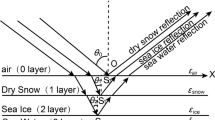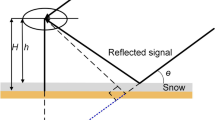Abstract
Measuring snow depth using the GPS interferometric reflectometry is an active microwave remote sensing technique and an emerging approach because of its relatively large spatial coverage and high temporal sampling capability. The current geodetic GPS networks are capable of measuring snow depth in the vicinity of the antenna installation at no additional hardware cost. However, the performance is constrained by the geodetic GPS antenna which was originally designed to minimize the reception of the reflected signal. In our prior work, we proposed a horizontally polarized antenna which has equal gain for both direct and reflected signals and tested its performance for a single snow event. In order to comprehensively assess its performance, we set up a horizontally polarized snow monitor (HPSM) using the improved antenna at Marshall, Colorado, USA, over the 2013–2014 water year. The data from the HPSM clearly shows that the proposed design has high sensitivity to even very light snowfalls. However, some anomalies are observed from the HPSM measurements, which tend to either overestimate or underestimate the actual snow depth. We explain the observed measurement anomalies by replacing the traditional air–snow single-interface model with an air–snow–soil dual-interface model. The effectiveness of the new model is validated by comparing the simulated results to the HPSM measurements. Utilizing the dual-interface model, we simulate the error curve for snow depth estimation given various snow depths and snow permittivities. The error curve shows that the estimation biases can be observed only for shallow snow with a relatively small permittivity value.












Similar content being viewed by others
References
Armstrong RL, Brun E (2008) Snow and climate: physical processes, surface energy exchange and modeling. Cambridge University Press, Cambridge
Balanis CA (2012) Advanced engineering electromagnetics. Wiley, New York
Barnett TP, Adam JC, Lettenmaier DP (2005) Potential impacts of a warming climate on water availability in snow-dominated regions. Nature 438:303–309. doi:10.1038/nature04141
Beckmann P, Spizzichino A (1987) The scattering of electromagnetic waves from rough surfaces. Artech House Inc., Norwood, MA
Born M, Wolf E (1980) Principles of optics. Pergamon Press, Oxford
Cardellach E, Fabra F, Rius A, Pettinato S, D’Addio S (2012) Characterization of dry-snow sub-structure using GNSS reflected signals. Remote Sens Environ 124:122–134. doi:10.1016/j.rse.2012.05.012
Chen Q, Won D, Akos DM (2014) Snow depth sensing using the GPS L2C signal with a dipole antenna. Eurasip J Adv Sig Process. doi:10.1186/1687-6180-2014-106
Chew CC, Small EE, Larson KM, Zavorotny VU (2015) Vegetation sensing using GPS-interferometric reflectometry: theoretical effects of canopy parameters on signal-to-noise ratio data. IEEE Trans Geosci Remote Sens 53(5):2755–2764. doi:10.1109/Tgrs.2014.2364513
Gutmann ED, Larson KM, Williams MW, Nievinski FG, Zavorotny V (2012) Snow measurement by GPS interferometric reflectometry: an evaluation at Niwot Ridge, Colorado. Hydrol Process 26(19):2951–2961. doi:10.1002/hyp.8329
Hallikainen MT, Ulaby FT, Dobson MC, Elrayes MA, Wu LK (1985) Microwave dielectric behavior of wet soil. 1. Empirical-models and experimental-observations. IEEE Trans Geosci Remote Sens 23:25–34. doi:10.1109/Tgrs.1985.289497
Jacobson MD (2010) Snow-covered lake ice in GPS multipath reception: theory and measurement. Adv Space Res 46(2):221–227. doi:10.1016/j.asr.2009.10.013
Larson KM, Gutmann ED, Zavorotny VU, Braun JJ, Williams MW, Nievinski FG (2009) Can we measure snow depth with GPS receivers. Geophys Res Lett 36:L17502. doi:10.1029/2009gl039430
Larson KM, Braun JJ, Small EE, Zavorotny VU, Gutmann ED, Bilich AL (2010) GPS multipath and its relation to near-surface soil moisture content. IEEE J Sel Top Appl Earth Observ 3(1):91–99. doi:10.1109/Jstars.2009.2033612
Lomb NR (1976) Least-squares frequency-analysis of unequally spaced data. Astrophys Space Sci 39(2):447–462. doi:10.1007/Bf00648343
Mironov VL, De Roo RD, Savin IV (2010) Temperature-dependable microwave dielectric model for an arctic soil. IEEE Trans Geosci Remote Sens 48(6):2544–2556. doi:10.1109/Tgrs.2010.2040034
Nievinski FG, Larson KM (2014a) Forward modeling of GPS multipath for near-surface reflectometry and positioning applications. GPS Solut 18(2):309–322. doi:10.1007/s10291-013-0331-y
Nievinski FG, Larson KM (2014b) Inverse modeling of GPS multipath for snow depth estimation-part I: formulation and simulations. IEEE Trans Geosci Remote Sens 52(10):6555–6563. doi:10.1109/Tgrs.2013.2297681
Nievinski FG, Larson KM (2014c) Inverse modeling of GPS multipath for snow depth estimation-part II: application and validation. IEEE Trans Geosci Remote Sens 52(10):6564–6573. doi:10.1109/Tgrs.2013.2297688
Rodriguez-Alvarez N, Bosch-Lluis X, Camps A, Vall-llossera M, Valencia E, Marchan-Hernandez JF, Ramos-Perez I (2009) Soil moisture retrieval using GNSS-R techniques: experimental results over a bare soil field. IEEE Trans Geosci Remote Sens 47(11):3616–3624. doi:10.1109/Tgrs.2009.2030672
Rodriguez-Alvarez N et al (2011a) Review of crop growth and soil moisture monitoring from a ground-based instrument implementing the interference pattern GNSS-R technique. Radio Sci 46(6):3. doi:10.1029/2011rs004680
Rodriguez-Alvarez N et al (2011b) Land geophysical parameters retrieval using the interference pattern GNSS-R technique. IEEE Trans Geosci Remote Sens 49(1):71–84. doi:10.1109/TGRS.2010.2049023
Rodriguez-Alvarez N et al (2012) Snow thickness monitoring using GNSS measurements. IEEE Trans Geosci Remote Sens Lett 9(6):1109–1113. doi:10.1109/Lgrs.2012.2190379
Shi JC, Dozier J (2000) Estimation of snow water equivalence using SIR-C/X-SAR, part I: inferring snow density and subsurface properties. IEEE Trans Geosci Remote Sens 38(6):2465–2474. doi:10.1109/36.885195
Ulaby FT, Moore RK, Fung AK (1981) Microwave remote sensing: active and passive, vol 3. Addison-Wesley, Reading, MA
Zavorotny VU, Larson KM, Braun JJ, Small EE, Gutmann ED, Bilich AL (2010) A physical model for GPS multipath caused by land reflections: toward bare soil moisture retrievals. IEEE J Sel Top Appl Earth Observ 3(1):100–110. doi:10.1109/Jstars.2009.2033608
Acknowledgments
The authors would thank Dr. John Braun of UCAR and Dr. Staffan Backén for their help in installing the instrument at Marshall Field. The authors would also thank Dr. Valery Zavorotny of NOAA for his invaluable help in the mathematical modeling.
Author information
Authors and Affiliations
Corresponding author
Rights and permissions
About this article
Cite this article
Chen, Q., Won, D. & Akos, D.M. Snow depth estimation accuracy using a dual-interface GPS-IR model with experimental results. GPS Solut 21, 211–223 (2017). https://doi.org/10.1007/s10291-016-0517-1
Received:
Accepted:
Published:
Issue Date:
DOI: https://doi.org/10.1007/s10291-016-0517-1




